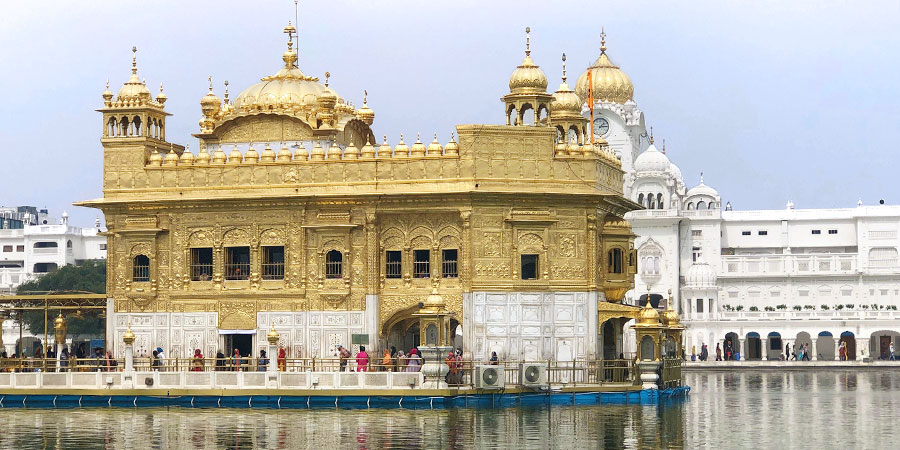Golden Temple, Amritsar (Harmandir Sahib or Darbar Sahib)
The Golden Temple, Amritsar (Harmandir Sahib or Darbar Sahib) is one of the most important pilgrimage sites of Sikhs. As you enter the Gurudwara, you are filled with a sense of piousness and religious fervor – an experience that cannot be explained in words. Built around a pool, the temple has been demolished and rebuilt several times, showcasing the resilient spirit of the people.The temple’s glittering dome is an easily recognizable fixture, and is often visited by travelers belonging to different religions. Easily accessible from different corners of the Amritsar, the temple stands as a symbol of communal harmony and brotherhood.
Interestingly, the sanctuary complex is just a small part of the elaborate multifaceted structure that houses a tank (Amrit Sarovar) and some other monuments and shrines. Let’s talk about this interesting shrine, and learn about its stunning history.

Golden Temple, Amritsar
|
History of Golden Temple
The Harmandir Saheb or Durbar Saheb is undoubtedly one of the most sacred sites in Sikhism. According to Sikh doctrines, the area now known as Amritsar was once a barren piece of land. The third Guru (teacher or spiritual guide), Guru Amar Das and later, his successor, Guru Ram Das excavated the sacred pool of the temple complex and founded a small village. With time, the village expanded and grew into what is now known as the city of Amritsar. According to records, the construction of the Golden Temple, Amritsar (Harmandir Sahib or Darbar Sahib) was initiated during 1574.During the subsequent years, the temple was destroyed by invaders and rebuilt several times. During the 19th century, the dome of the temple was decorated with gold under the patronage of Maharaja Ranjit Singh.
Architecture and Interiors
One of the stunning examples of Indian and Islamic style architecture, the Golden Temple is a remarkable structure. When observed from a distance, the temple gives out an illusion of floating on the Amrit Sarovar. The two-level structures are decorated with stunning motifs inspired by nature and elaborate gold panels.As devotes cross the long causeway, they are greeted by musicians and priests who are chanting the Guru Granth Sahib – the holy book of the Sikhs. After paying their respects, the devotees move to the higher floor.
Daily Ceremonies and Important Festivals
The morning at the Golden Temple, Amritsar (Harmandir Sahib or Darbar Sahib) begins with Prakash (meaning light in Sanskrit). Each day during the dawn, the Guru Granth Sahib is brought out of its Akal Takht, where priests carry it to sanctum sanctorum on an elaborately decorated palanquin.Amidst the ritualistic hymns (kirtans and ardas), the book reaches the inner sanctum where the priest opens up a random page of the book and reads it aloud for the devotees. This ritualistic reading is known as mukhwah. At the end of the day, after a series of devotional songs, the holy book is closed for the day and taken back to Akal Takht, where it is tucked into its bed! The entire ritual is known as Palki Sahib.
An important festival of Sikhism, Baisakhi, is an elaborately celebrated at Golden Temple. The festival marks the beginning of the Khalsa order. During the day, early morning processions and other religious ceremonies are organized within the temple complex. At night, the temple is decorated with elaborate festive lightings and decorations.
Other important festivals celebrated in the Golden Temple, Amritsar (Harmandir Sahib or Darbar Sahib) include Diwali and birthdays of important gurus of Sikhism.
|
|
|
Guru-Ka-Langar - World's Largest Free Kitchen
An interesting part of the temple complex is its free kitchen – it is one of the largest in the world. Each day close to millions of visitors samples the mouth-watering Prasad (divine offering as food) at the huge dining hall – Guru-Ka-Langar – of the holy place. The food is freshly made at the temple kitchen complex and served to visitors irrespective of their religion.The food is entirely free, but devotees make donations or offer their service in the kitchen or other sections of langar (the kitchen service). The service or Seva offered at the langar is considered as a good deed or karma.
Some Important Sections of the Golden Temple
The important sections and monuments of the Golden Temple include:• Akal Takht and Teja Singh Samundri Hall
• Darshani Deorhi
• Clock Tower
• Amrit Sarovar
• Guru-ka-Langar
• Central Sikh Museums
How to Reach Golden Temple
Golden temple is an important landmark of Amritsar and could be reached from any corner of the city. The local mode transports including public buses or auto-rickshaws could be availed for the trip. The nearest airport to Amritsar is Raja Sansi International Airport located 11km (6.8mi) away from the city. Apart from that, trains from Delhi and nearby cities are also available.Timings: Dawn to 22:00
Entrance Fee: Free
Some Other Important Things to Remember
1. Before entering the temple complex, remove your shoes and cover your head. The shoes can be kept at the free facility close to the entrance of the temple. Bandanas could be bought from the souvenir shops.2. For the occasion, remember to wear dresses that cover the entire body. Ideally, carrying a scarf for covering the head is important.
3. Photography is prohibited inside the temple premises.
4. Consumption of alcohol or smoking inside the temple premise is strictly prohibited.
5. While sitting beside Amrit Sarovar, remember to sit cross-legged. It is considered impolite to dip the feet in the water.
6. As a sign of reverence, do sit and listen to Gurbani (extracts from Guru Granth Sahib) at the Darbar Sahib.
The trip to the Golden Temple, Amritsar (Harmandir Sahib or Darbar Sahib) is a soulful experience that will fill your heart and soul lasting peace.
See More about: 16 Stunning Places to Visit in North India


